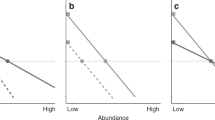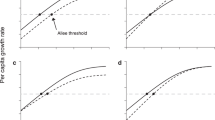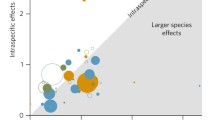Abstract
Rarity is common and widespread. As early as 1859 Charles Darwin wrote that ‘rarity is the attribute of a vast number of species in all classes, in all countries’. All species are rare somewhere, and most species are rare toward the periphery of their ranges (Hanski, 1982; Brown, 1984; Hanski et al., 1993). The majority of species comprising local biotas are rare (Preston, 1948; Hubbell, 1979). Indeed, the rarity of most species gave rise to a major school of ecological thought, which asserted that populations were typically regulated by density-independent factors acting at low population densities rather than by density-dependent factors, such as competition, whose effects should be most strongly felt at high population densities (Andrewartha and Birch, 1954).
Access this chapter
Tax calculation will be finalised at checkout
Purchases are for personal use only
Preview
Unable to display preview. Download preview PDF.
Similar content being viewed by others
References
Anderson, W.R. (1973) A morphological hypothesis for the origin of heterostyly in the Rubiaceae. Taxon, 42, 537–542.
Andrewartha, H.G. and Birch, L.C. (1954) The Distribution and Abundance of Animals. University of Chicago Press, Chicago.
Ashman, T.-L. and Schoen, D.J. (1994) How long should flowers live? Nature (London), 371, 788–791.
Baker, H.G. (1958) Studies in the reproductive biology of West African Rubiaceae. Journal of the West African Science Association, 4, 9–24.
Bannister, M.H. (1965) Variation in the breeding system of Pinus radiata, in The Genetics of Colonizing Species, (eds H.G. Baker and G.L. Stebbins), Academic Press, New York, pp. 353–374.
Barrett, S.C.H. (1989) Mating system evolution and speciation in heterostylous plants, in Speciation and Its Consequences (eds D. Otte and J.A. Endler), Sinauer Associates, Sunderland, MA, pp. 257–283.
Barrett, S.C.H. and Richards, J.H. (1990) Heterostyly in tropical plants. Memoirs of the New York Botanical Garden, 55, 35–61.
Bawa, K.S. and Beach, J.S. (1983) Self-incompatibility systems in the Rubiaceae of a tropical lowland wet forest. American Journal of Botany, 70, 1281–1288.
Bazzaz, F.A., Chiariello, N.R., Coley, P.D. and Pitelka, L.F. (1987) Allocating resources to reproduction and defense. BioScience, 37, 58–67.
Beach, J.H. and Bawa, K.S. (1980) Role of pollinators in the evolution of dioecy from distyly. Evolution, 34, 1138–1142.
Berenbaum, M. (1981a) Effects of linear furanocoumarins on an adapted specialist insect (Papilio polyxenes). Ecological Entomology, 6, 345–351.
Berenbaum, M. (1981b) Patterns of furanocoumarin distribution and insect herbivory in the Umbelliferae: plant chemistry and community structure. Ecology, 62, 1254–1266.
Brown, J.H. (1984) On the relationship between abundance and distribution of species. American Naturalist, 124, 255–279.
Burgess, K.H. (1991) Florivory: The ecology of flower feeding insects and their host plants. PhD Thesis, Harvard University.
Cartar, R. and Dill, L. (1990) Why are bumblebees risk-sensitive foragers? Behavioral Ecology and Sociobiology, 26, 121–127.
Cates, R.G. and Orians, G.H. (1975) Successional status and the palatability of plants to generalist herbivores. Ecology, 56, 410–418.
Chew, F.S. (1975) Coevolution of pierid butterflies and their cruciferous food plants. I. The relative quality of available resources. Oecologia, 20, 117–127.
Coley, P.D., Bryant, J.P. and Chapin, F.S. III (1985) Resource availability and plant antiherbivore defense. Science, 230, 895–899.
Croat, T.B. (1978) Flora of Barro Colorado Island, Stanford University Press, Stanford.
Darwin, C. (1859) On the Origin of Species, Murray, London.
Dajoz, I., Till-Bottraud, I. and Gouyon, P.-H. (1991) Evolution of pollen morphology. Science, 253, 66–68.
Dodson, C.H. (1962) The importance of pollination in the evolution of the orchids of tropical America. American Orchid Society Bulletin, 31, 525–534.
Dodson, C.H. (1962) The importance of pollination in the evolution of the orchids of tropical America. American Orchid Society Bulletin, 31, 641–649.
Dodson, C.H. (1962) The importance of pollination in the evolution of the orchids of tropical America. American Orchid Society Bulletin, 31, 731–735.
Donoghue, M. J. and Doyle, J. A. (1989) Phylogenctic analysis of angiosperms and the relationships of Hamamelidae, in Evolution, Systematics, and Fossil History of the Hamamelidae, Vol. 1 (eds P.R. Crane and S. Blackmore), Clarendon Press, Oxford, pp. 17–45.
Erdtman, G. (1966) Pollen Morphology and Plant Taxonomy, Hafner, New York.
Feeny, P. (1976) Plant apparency and chemical defense. Recent Advances in Phytochemistry, 10, 1–40.
Feinsinger, P., Murray, K.G., Kinsman, S. and Busby, W.H. (1986) Floral neighborhood and pollination success in four hummingbird-pollinated cloud forest plant species. Ecology, 67, 449–464.
Fiedler, P.L. (1987) Life history and population dynamics of rare and common mariposa lilies (Calochortus Pursh: Liliaceae). Journal of Ecology, 75, 977–995.
Futuyma, D.J. (1976) Food plant specialization and environmental predictability in Lepidoptera. American Naturalist, 110, 285–292.
Gass, C.L. and Roberts, W.M. (1992) The problem of temporal scale in optimization: three contrasting views of hummingbird visits to flowers. American Naturalist, 140, 829–853.
Hamilton, C.W. (1989a) A revision of Mesoamerican Psychotria subgenus Psychotria (Rubiaceae), part 1: Introduction and species 1–16. Annals of the Missouri Botanical Garden, 76, 67–111.
Hamilton, C.W. (1989b) A revision of Mesoamerican Psychotria subgenus Psychotria (Rubiaceae), part 2: Species 17–47. Annals of the Missouri Botanical Garden, 76, 386–429.
Hamilton, C.W. (1989c) A revision of Mesoamerican Psychotria subgenus Psychotria (Rubiaceae), part 3: Species 48–61 and appendices. Annals of the Missouri Botanical Garden, 76, 886–916.
Hamilton, C.W. (1990) Variations on a distylous theme in Mesoamerican Psychotria subgenus Psychotria (Rubiaceae). Memoirs of the New York Botanical Garden, 55, 62–75.
Hanski, I. (1982) Dynamics of regional distribution: the core and satellite species hypothesis. Oikos, 38, 210–221.
Hanski, I., Kouki, J. and Halkka, A. (1993) Three explanations of the positive relationship between distribution and abundance of species, in Species Diversity in Ecological Communities (eds R.E. Ricklefs and D. Schluter), University of Chicago Press, Chicago, pp. 108–116.
Harper, K.T. (1979) Some reproductive and life history characteristics of rare plants and implications for management. Great Basin Naturalist Memoirs, 3, 129–137.
Hoekstra, F.A. (1983) Physiological evolution in angiosperm pollen: possible role of pollen vigor, in Pollen: Biology and Implications for Plant Breeding (eds D.L. Mulcahy and E. Ottaviano), Elsevier Biomedical, New York, NY, pp. 35–41.
Hubbell, S.P. (1979) Tree dispersion, abundance, and diversity in a tropical dry forest. Science, 203, 1299–1309.
Jennersten, O. (1988) Pollination in Dianthus deltoides (Caryophyllaceae): effects of habitat fragmentation on visitation and seed-set. Conservation Biology, 2, 359–366.
Karron, J.D. (1987) A comparison of levels of genetic polymorphism and self-compatibility in geographically restricted and widespread plant congeners. Evolutionary Ecology, 1, 47–58.
Kunin, W.E. (1991) Few and far between: plant population density and its effects on insect–plant interactions. PhD Thesis, University of Washington, Seattle.
Landa, K. and Rabinowitz, D. (1983) Relative preferences of Arphia sulphurea (Orthoptera: Acrididae) for sparse and common prairie grasses. Ecology, 64, 392–395.
Levin, D.A. (1995) Plant outliers: an ecological perspective. American Naturalist, 145, 109–118.
Macior, L.W. (1978.) The pollination ecology and endemic adaptation of Pedicularis furbishiae S. Wats. Bulletin of the Torrey Botanical Club, 105, 268–277.
Martin, F.W. (1967) Distyly, self-incompatibility, and evolution in Melochia. Evolution, 21, 493–499.
McNeill, J. and Crompton, C.W. (1978) Pollen dimorphism in Silene alba (Caryophyllaceae). Canadian Journal of Botany, 56, 1280–1286.
Mehrhoff, L.A. III (1983) Pollination in the genus Isotria (Orchidaccac). American Journal of Botany, 70, 1444–1453.
Mulcahy, D.L. (1974) Correlation between speed of pollen tube growth and seedling height in Zea mays L. Nature (London), 249, 491–493.
Mulcahy, D.L. and Mulcahy, G.B. (1975) The influence of gametophytic competition on sporophytic quality in Dianthus chinensis. Theoretical and Applied Genetics, 46, 277–280.
Murawski, D.A., Hamrick, J.L., Hubbell, S.P. and Foster, R.B. (1990) Mating systems of two bombacaceous trees of a Neotropical forest. Oecologia, 82, 501–506.
Nilsson, L.A. (1992) Orchid pollination biology. Trends in Ecology and Evolution, 7, 255–259.
Noss, R.E. and Cooperrider, A.Y. (1994) Saving Nature’s Legacy, Island Press, Covelo, CA.
Oostermeijer, J.G., Den Nijs, J.C.M., Raijmann, L.W.E.L. and Menken, S.B.J. (1992) Population biology and management of the marsh gentian (Gentiana pneumonanthe L.), a rare species in the Netherlands. Botanical Journal of the Linnean Society, 108, 117–130.
Ornduff, R. (1966) The origins of dioecism from heterostyly in Nymphoides (Menyanthaceae). Evolution, 20, 309–314.
Preston, F.W. (1948) The commonness, and rarity, of species. Ecology, 29, 254–283.
Primack, R.B. (1985) Longevity of individual flowers. Annual Review of Ecology and Systematics, 16, 15–37.
Rabinowitz, D. (1981) Seven forms of rarity, in The Biological Aspects of Rare Plant Conservation (ed. H. Synge), John Wiley and Sons, New York, pp. 205–217.
Rabinowitz, D. and Rapp, J.K. (1981) Dispersal abilities of seven sparse and common grasses from a Missouri prairie. American Journal of Botany, 65, 616–624.
Rabinowitz, D, Rapp, J.F., and Dixon, P.M. (1984) Competitive abilities of sparse grass species: means of persistence as a cause of abundance. American Journal of Botany, 68, 1144–1154.
Rabinowitz, D., Rapp, J.K., Cairns, S. and Mayer, M. (1989) The persistence of rare prairie grasses in Missouri: environmental variation buffered by reproductive output of sparse species. American Naturalist, 134, 525–544.
Real, L.A. (1981) Uncertainty and pollinator-plant interactions: the foraging behavior of bees and wasps on artificial flowers. Ecology, 62, 20–26.
Rhoadcs, D.F. and Cates, R.G. (1976) Toward a general theory of plant antiherbivore chemistry. Recent Advances in Phytochemistry, 10, 168–213.
Richards, A.J. (1986) Plant Breeding Systems, Allen and Unwin, London.
Ricklefs, R.E. and Cox, G.W. (1972) Taxon cycles in the West Indian avifauna. American Naturalist, 106, 195–219.
Sih, A. and Baltus, M.-S. (1987) Patch size, pollinator behavior, and pollination limitation in catnip. Ecology, 68. 1679–1690.
Smyth, C.A. and Hamrick, J.L. (1984) Variation in estimates of outcrossing in musk thistle populations. Journal of Heredity, 75, 303–307.
Snow, A.A. and Spira, T.P. (1991) Pollen vigor and the potential for sexual selection in plants. Nature (London), 352, 766–797.
Squillace, A.E. and Krause, J.R. (1963) The degree of natural selfing in slash pine as estimated from albino frequencies. Silvae Genetica, 12, 46–50.
Terborgh, J. and Winter, B. (1980) Some causes of extinction, in Conservation Biology: an evolutionary-ecological perspective (eds M.E. Soulé and B.A. Wilcox), Sinauer Associates, Sunderland, MA, pp. 119–133.
Thornhill, R. and Alcock, J. (1983) The Evolution of insect Mating Systems, Harvard University Press, Cambridge, MA.
Wheelwright, N.T. and Orians, G.H. (1982) Seed dispersal by animals: contrasts with pollen dispersal, problems of terminology, and constraints on coevolution. American Naturalist, 119, 402–413.
Wilson, E.O. (1961) The nature of the taxon cycle in the Melanesian ant fauna. American Naturalist, 95, 1659–193.
Wolf, L.L. and Hainsworth, F.R. (1983) Economics of foraging strategies in sunbirds and hummingbirds, in Behavioral Energetics: The Cost of Survival in Vertebrates (eds E.P. Aspey and S.I. Lustic), Ohio State University Press, Columbus, OH, pp. 223–264.
Editor information
Editors and Affiliations
Rights and permissions
Copyright information
© 1997 Springer Science+Business Media Dordrecht
About this chapter
Cite this chapter
Orians, G.H. (1997). Evolved consequences of rarity. In: Kunin, W.E., Gaston, K.J. (eds) The Biology of Rarity. Population and Community Biology Series, vol 17. Springer, Dordrecht. https://doi.org/10.1007/978-94-011-5874-9_11
Download citation
DOI: https://doi.org/10.1007/978-94-011-5874-9_11
Publisher Name: Springer, Dordrecht
Print ISBN: 978-94-010-6483-5
Online ISBN: 978-94-011-5874-9
eBook Packages: Springer Book Archive




